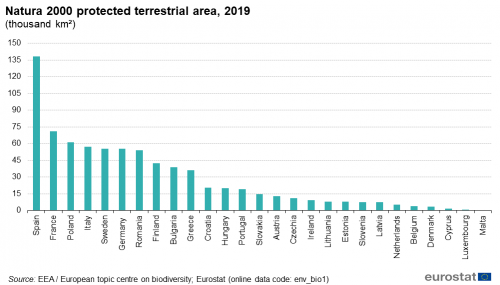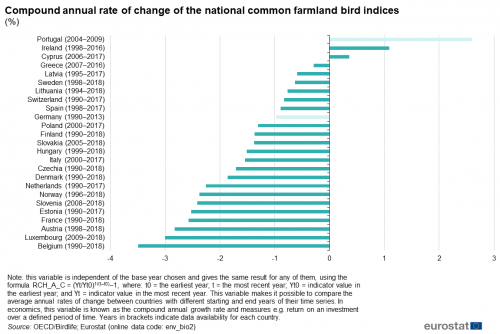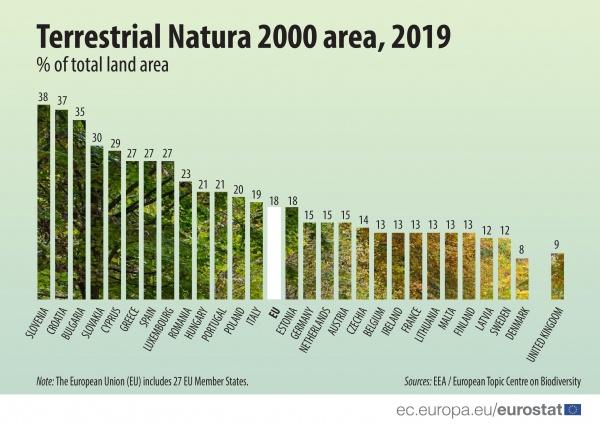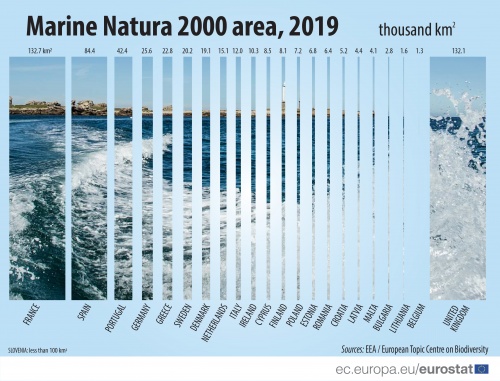Archive:Biodiversity statistics
Data from April 2020
Planned article update: December 2020
Highlights
In 2019, 18% of the land of the EU was protected as Natura 2000, with the lowest share of protected land in Denmark (8%) and highest in Slovenia (38%).
In 2019, The largest national network of terrestrial Natura 2000 sites was located in Spain, covering 138 111 km2, followed by France (70 875 km2) and Poland (61 168 km2).
More than 440 000 km2 of EU-27‘s marine waters were protected as marine Natura 2000 areas in 2019, an increase of 5% compared with 2018 and 150% since 2013.
<highlight>
Biodiversity encompasses the number, variety and variability of plants, animals and other organisms, including humans. We depend on the natural richness of our planet for the food, energy, raw materials, clean air and water that make life possible and underpin our economies; therefore, it is essential to prevent a loss of biodiversity — any loss may not only undermine the natural environment, but also our economic and social goals.
Biodiversity and its human-induced decline have become a topic of international concern. A 2019 report of the Intergovernmental Science-Policy Platform on Biodiversity and Ecosystem Services (IPBES) reported an accelerated extinction of species and decline in ecosystem health at a global level. A survey carried out in EU Member States in December 2018 (>27 000 respondents) as part of Eurobarometer showed an increasing awareness of the meaning and importance of biodiversity among EU citizens. Most recently, the European Commission adopted The European Green Deal, an ambitious vision for a sustainable, green transition that is just and socially fair. Biodiversity is one of its key policy areas.
This article examines two indicators for biodiversity in the European Union — information on protected areas (for terrestrial and marine biodiversity) and bird populations.
Full article
Natura 2000 - the cornerstone of biodiversity protection in the EU
The EU has the largest coordinated network of protected areas in the world; it is knows as Natura 2000 and consist of ca 27 000 sites. The Natura 2000 network stems from the legal basis provided by the Habitats Directive and the Birds Directive ("the Nature Directives"). Areas to be protected under these two directives are proposed by the EU Member States. Natura 2000 areas do not necessarily overlap with protected areas designated under national legislation of Member States - its objective is to ensure the preservation of most valuable and threatened species and habitats of the EU. Economic activities are allowed under Natura 2000 as long as they do not affect the conservation status of species or habitats in a negative way.
Protected terrestrial areas
Nearly 764 000 km2 of the EU-27‘s terrestrial area were protected or proposed for protection as Natura 2000 sites as of 2019, i.e. 18 % of the total land area of the EU. The largest network of terrestrial Natura 2000 areas in absolute terms is located in Spain - in 2019 it covered 138 111 km2. This is almost twice the size of the next largest national Natura 2000 network - the French one (70 875 km2) - and it is larger than the country area of the 19 smallest EU Member States.
Some Member States protect a large proportion of their national territory as Natura 2000 sites. All EU Member States of the Balkan Peninsula have designated more than 20 % ot their land area as Natura 2000; most notably Slovenia (38 %), Croatia (37 %) and Bulgaria (35 %). Other Member States which protect more than a quarter of their land as terrestrial Natura 2000 network are Slovakia (30 %), Cyprus (29 %), Spain and Luxembourg (both 27 %). On the other end of the spectrum we find Denmark (8 %), Sweden and Latvia (both 12 %), and six other Member States that have designated 13 % of their land territory as Natura 2000 sites. It is important to note that, in general, biodiversity in Europe decreases from south to north (or from the Equator to the Pole) which partly explains the geographical pattern we observe.
The process of designating terrestrial Natura 2000 areas is well advanced; therefore, the total extent of the national network of terrestrial Natura 2000 in most Member States in recent years remained unchanged. The only country where an increase of more than 1 % in the terrestrial Natura 2000 network was recorded between 2018 and 2019 was Bulgaria (1.3 %).
Figure 1 shows the total extent of the national terrestrial Natura 2000 network for all Member States for 2019 and also the share of their land area protected as Natura 2000.
<image zoom="100">
Source: EEA / European topic centre on biodiversity; Eurostat (env_bio1)
Protected marine areas
More than 440 000 km2 of EU-27‘s marine waters were protected as marine Natura 2000 areas in 2019. This, for the EU as a whole, represents a 5 % increase compared with 2018 and almost a 150 % since 2013 (i.e. since the latest Member State joined the EU). In absolute terms, the largest national network of marine Natura 2000 areas is located in coastal waters around France (132 689 km2). Together with the second largest national network - in Spain (84 405 km2) - these account for almost half (49 %) of the total marine Natura 2000 area of the EU.
Unlike the terrestrial Natura 2000 sites, where the designation process is much more advanced and the coverage in Member States has remained largely unchanged for the past years, for marine areas some Member States achieved a large progress in their designation between 2018 and 2019. These were, in particular, Cyprus (more than 6300 % or ca 8 300 km2), Italy (76 % or ca 5 200 km2), Portugal (12 % or ca 4 400 km2) Croatia (5 % or ca 300 km2) and France (2 % or ca 3 100 km2).
Figure 2 shows the progress of the designation of marine Natura 2000 areas by Member States between 2018 and 2019, and the overall progress of the EU-27 between 2013 and 2019.

(thousand km²)
Source: EEA / European topic centre on biodiversity; Eurostat (env_bio1)
The condition of protected areas
Eurostat does not collect or republish data about qualitative aspects of protected areas (i.e. their condition or "conservation status") which may provide a better indication of the state and trends in biodiversity than the size or coverage of protected areas. The European Environment Agency concluded in their report The European environment - state and outlook 2020 that 60 % of species and 77 % of habitats listed in the Habitats Directive showed predominantly unfavourable conservation status.
<sesection>
Populations of common birds
Being relatively easy to monitor, compared with many other groups of organisms, and sensitive to changes in the environment, including pollution and habitat modification, birds have been used as an important indicator of the state of the environment. Figure 3 shows the overall change in the three bird indices for the EU (common farmland bird index, common forest bird index and index of all common birds), expressed numerically through the compound annual rate of change (R_CH in the legend). This variable indicates the overall development of each of the three bird indices without taking the annual fluctuations into account. Bird indices show that populations of all three groups of common birds declined over the period 1990 – 2017, with a much steeper decline observed for common farmland birds (-1.47 %) than for the other two groups. These annual rates of change translate into a 33.2 % decline for common farmland birds, 4.7 % decline for common forest birds and 9.7 % decline for all common birds in the EU.

(aggregated index of population estimates of selected groups of breeding bird species, 2017 = 100)
Source: EBCC / BirdLife / RSPB / Czech Ornithological Society; Eurostat (env_bio3)
In addition to the aggregate EU bird indices which are calculated using data for a suite of species common for all EU countries participating in the pan-European common bird monitoring scheme, and which are shown in Figure 3, countries also calculate national, country-specific indices for common farmland birds. For these, countries select their suite of common farmland species, which may differ from the suite of other European countries. Figure 4 provides an overview of compound annual rates of change in national common farmland bird indices for countries. Please note, the time coverage of the data differs in some countries; this is shown in the label of the y axis. The compound annual rate of change makes it possible to compare the average annual rates of change in countries with different starting and end years of their time series. Of the 23 countries that compiled data up to the most recent years (i.e. 2016–2018), only data for Cyprus and Ireland suggested an increase in the national farmland bird index. The largest decreases in the population of common farmland birds were recorded in Luxembourg and Belgium (more than 3 % decrease per year).

(%)
Source: OECD; Eurostat (env_bio2)
Source data for tables and graphs
Data sources
Habitats
Annual data are available on terrestrial and marine areas protected under the Habitats Directive (92/43/EEC) of 21 May 1992 on the conservation of natural habitats and of wild fauna and flora. The Directive protects over 1 000 animal and plant species and more than 200 types of habitat (for example, special types of forests, meadows or wetlands), which are considered to be of European importance. It has led to the creation of a network of protected special areas of conservation (SACs). Together with the special protection areas (SPAs) defined by the Birds Directive of 2 April 1979, codified by Directive 2009/147/EU of 30 November 2009, these areas make up the Natura 2000 network of protected areas, designed to ensure the long-term survival of Europe's most valuable and threatened species and habitats.
Birds
Across the EU, the conservation of wild birds is covered by Council Directive 79/409/EEC of 2 April 1979, as codified by Directive 2009/147/EU of 30 November 2009. Birds are considered to be good proxies for measuring the diversity and integrity of ecosystems as they tend to be near the top of the food chain, have large ranges and the ability to move elsewhere when their environment becomes unsuitable; they are therefore responsive to changes in their habitat. Birds are thus a recognised ecological indicator taxon.
The EU indices are based on data from 26 EU Member States (data for Croatia and Malta are not available), derived from annually operated surveys of national breeding birds collated by the Pan-European Common Bird Monitoring Scheme (PECBMS); these data are considered to be a good proxy for the whole of the EU.
Three different indices are presented:
- Common farmland birds (39 species)
- Common forest birds (34 species)
- All common birds (168 species)
For the first two categories, the bird species have a high dependence on agricultural or on forest habitats in the nesting season and for feeding. Both groups comprise year-round residents and migratory species. The index ‘All common birds’ comprises farmland and forest species together with other common species that are generalists, meaning that they occur in many different habitats or are particularly adapted to life in cities.
Context
In 1998, the EU adopted a biodiversity strategy. Four action plans covering the conservation of natural resources, agriculture, fisheries, and economic and development cooperation were subsequently agreed as part of this strategy in 2001. As a follow-up, in May 2011, the European Commission adopted Communication "Our life insurance, our natural capital: an EU biodiversity strategy to 2020"), aimed at halting the loss of biodiversity and ecosystem services in the EU by 2020. The Strategy had six main targets covering the areas of nature conservation, ecosystem services, sustainable agriculture and forestry, management of fish stocks, control over invasive alien species and the EU contribution to averting biodiversity loss at the global level, and 20 actions to help reach the main goal.
In 2015, the European Commission reviewed the EU biodiversity strategy to 2020 at mid-term to determine whether we were on track to reach its targets. The review found that no significant progress towards the 2020 headline target had been made. The only target found to be on track was the one on combating invasive alien species. To step up actions and bring us closer to meeting the goals of the EU Biodiversity Strategy to 2020, in May 2017, the European Commission adopted the Nature Action Plan (An Action Plan for nature, people and the economy).
Currently, the new EU Biodiversity Strategy to 2030 is being prepared, with a view to adopt it by the end of May 2020.
The EU’s biodiversity strategy is based on the implementation of two landmark Directives, the Habitats Directive (92/43/EEC) of 21 May 1992 and the Birds Directive (79/409/EEC)) of 2 April 1979, as codified by Directive 2009/147/EU of 30 November 2009.
Direct access to
Database
- Environment (env), see:
- Biodiversity (env_biodiv)
- Protected Areas for biodiversity: Habitats Directive (env_bio1)
- Common farmland bird index (env_bio2)
- Common bird indices by type of estimate (EU aggregate) (env_bio3)
- Communication 'The European Green Deal'
- Mid-term review of the EU Biodiversity Strategy to 2020
- Summaries of EU legislation: The EU biodiversity strategy: a current review of progress
- Communication 'Halting the loss of biodiversity by 2010 — and beyond — Sustaining ecosystem services for human well-being'
- Communication 'Our life insurance, our natural capital: an EU biodiversity strategy to 2020'
- Summaries of EU legislation: Biodiversity strategy for 2020
- Directive 79/409/EEC ('Birds Directive') of 2 April 1979 on the conservation of wild birds
- Directive 79/409/EEC ('Habitats Directive') on the conservation of natural habitats and of wild fauna and flora
- Summaries of EU legislation: Protecting Europe’s biodiversity (Natura 2000)

